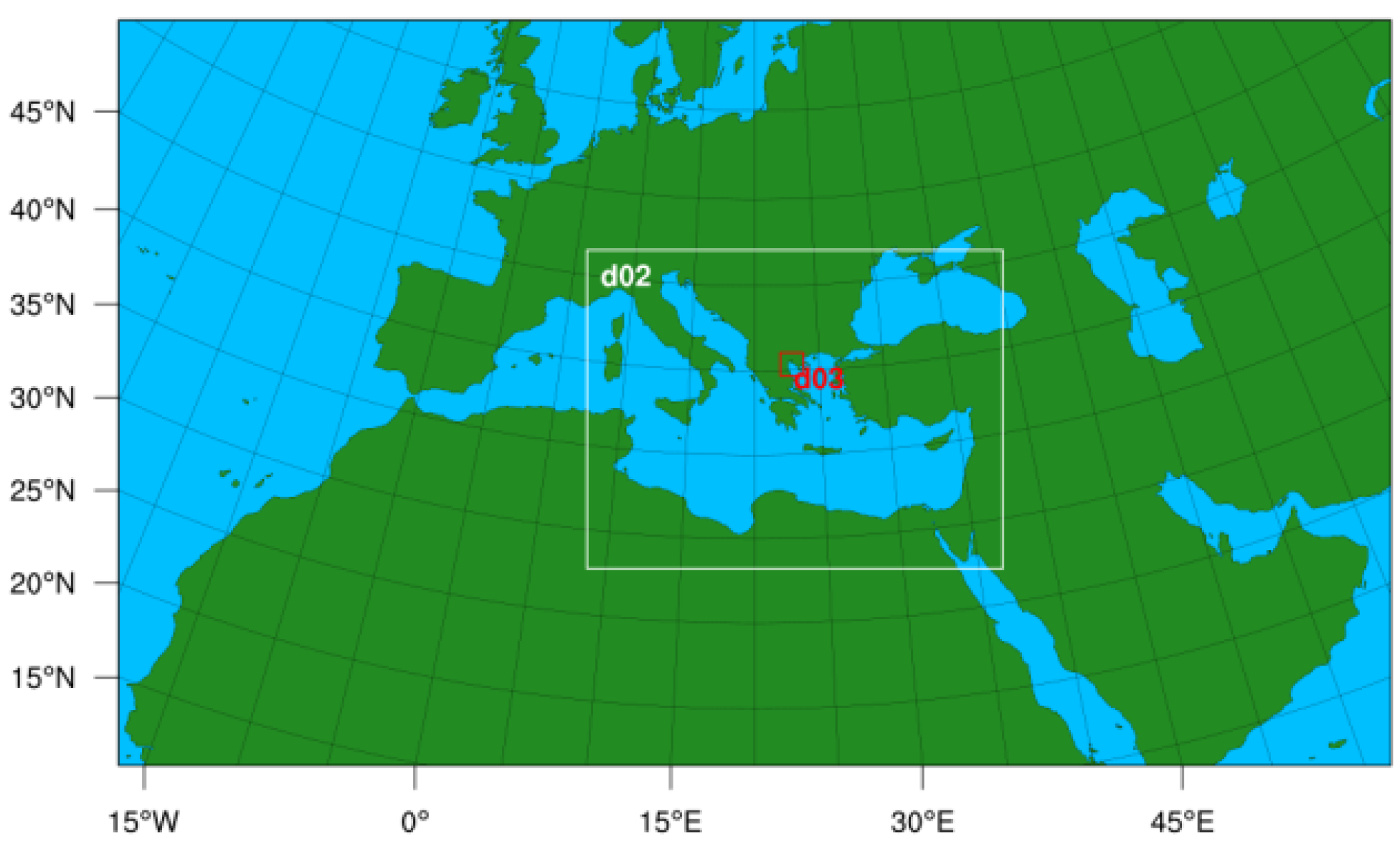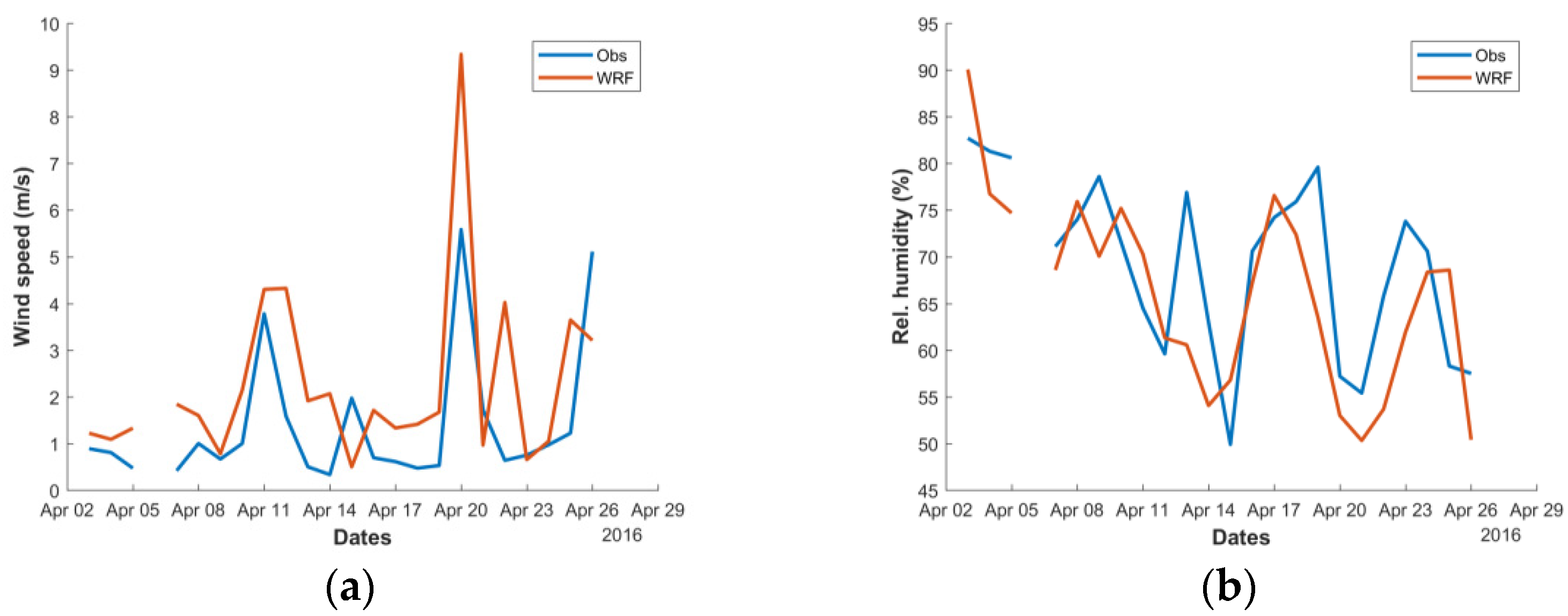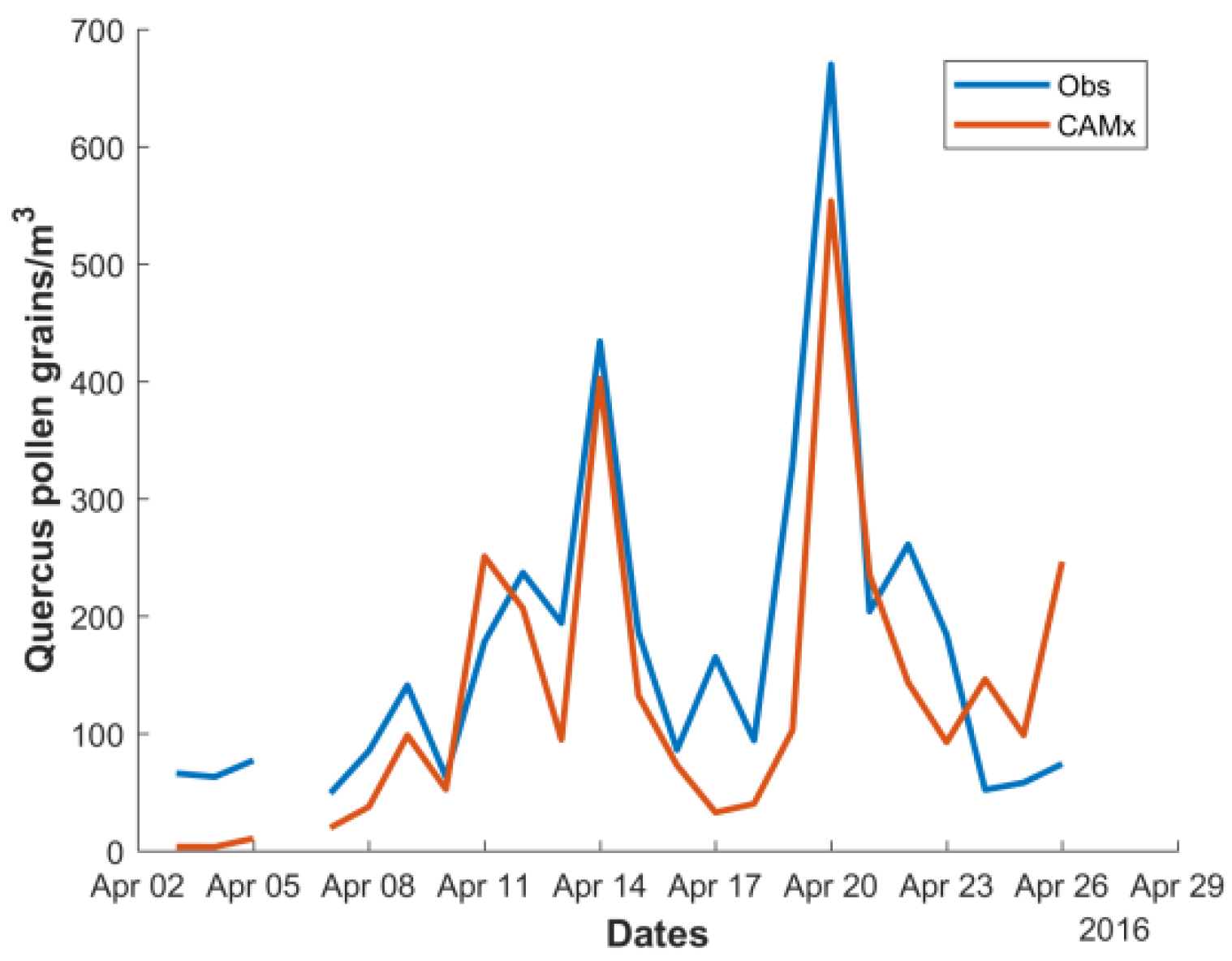Estimating the Exposure Levels of Quercus Pollen: A Case Study in the Greater Area of Thessaloniki, Greece †
Abstract
:1. Introduction
2. Materials and Methods
2.1. Modeling System
2.2. Measurements and Evaluation
3. Results
4. Discussion
5. Conclusions
Author Contributions
Funding
Informed Consent Statement
Data Availability Statement
Acknowledgments
Conflicts of Interest
References
- D’amato, G.; Cecchi, L.; Bonini, S.; Nunes, C.; Annesi-Maesano, I.; Behrendt, H.; Liccardi, G.; Popov, T.; Van Cauwenberge, P. Allergenic pollen and pollen allergy in Europe. Allergy 2007, 62, 976–990. [Google Scholar] [CrossRef] [PubMed]
- Taylor, P.E.; Flagan, R.C.; Valenta, R.; Glovsky, M.M. Release of allergens as respirable aerosols: A link between grass pollen and asthma. J. Allergy Clin. Immunol. 2002, 109, 51–56. [Google Scholar] [CrossRef]
- Bachert, C.; Van Cauwenberge, P.; Olbrecht, J.; Van Schoor, J. Prevalence, classification and perception of allergic and nonallergic rhinitis in Belgium. Allergy 2006, 61, 693–698. [Google Scholar] [CrossRef]
- Bauchau, V.; Durham, S. Prevalence and rate of diagnosis of allergic rhinitis in Europe. Eur. Respir. J. 2004, 24, 758–764. [Google Scholar] [CrossRef] [PubMed]
- Bousquet, J.; Khaltaev, N.; Cruz, A.A.; Denburg, J.; Fokkens, W.; Togias, A.; Zuberbier, T.; Baena-Cagnani, C.E.; Canonica, G.; Van Weel, C. Allergic rhinitis and its impact on asthma (ARIA) 2008. Allergy 2008, 63, 8–160. [Google Scholar]
- Katelaris, C.H.; Lee, B.W.; Potter, P.C.; Maspero, J.F.; Cingi, C.; Lopatin, A.; Saffer, M.; Xu, G.; Walters, R.D.J.C.; Allergy, E. Prevalence and diversity of allergic rhinitis in regions of the world beyond E urope and N orth A merica. Clin. Exp. Allergy 2012, 42, 186–207. [Google Scholar] [CrossRef]
- Long, A.; McFadden, C.; DeVine, D.; Chew, P.; Kupelnick, B.; Lau, J. Management of allergic and nonallergic rhinitis. Evid. Rep. Technol. Assess. 2002, 54, 1–6. [Google Scholar]
- Manifesto, A. Tackling the Allergy Crisis in Europe-Concerted Policy Action Needed. 2015. Available online: https://www.eaaci.org/ (accessed on 13 September 2021).
- James, S.L.; Abate, D.; Abate, K.H.; Abay, S.M.; Abbafati, C.; Abbasi, N.; Abbastabar, H.; Abd-Allah, F.; Abdela, J.; Abdelalim, A. Global, regional, and national incidence, prevalence, and years lived with disability for 354 diseases and injuries for 195 countries and territories, 1990–2017: A systematic analysis for the Global Burden of Disease Study 2017. Lancet 2018, 392, 1789–1858. [Google Scholar] [CrossRef] [Green Version]
- Charalampopoulos, A.; Damialis, A.; Tsiripidis, I.; Mavrommatis, T.; Halley, J.M.; Vokou, D.J.A. Pollen production and circulation patterns along an elevation gradient in Mt Olympos (Greece) National Park. Aerobiologia 2013, 29, 455–472. [Google Scholar] [CrossRef]
- Damialis, A.; Fotiou, C.; Halley, J.M.; Vokou, D. Effects of environmental factors on pollen production in anemophilous woody species. Trees 2011, 25, 253–264. [Google Scholar] [CrossRef]
- Helbig, N.; Vogel, B.; Vogel, H.; Fiedler, F.J.A. Numerical modelling of pollen dispersion on the regional scale. Aerobiologia 2004, 20, 3–19. [Google Scholar] [CrossRef]
- Hidalgo, P.J.; Mangin, A.; Galán, C.; Hembise, O.; Vázquez, L.M.; Sanchez, O. An automated system for surveying and forecasting Olea pollen dispersion. Aerobiologia 2002, 18, 23–31. [Google Scholar] [CrossRef]
- Liu, L.; Solmon, F.; Vautard, R.; Hamaoui-Laguel, L.; Torma, C.Z.; Giorgi, F.J.B. Ragweed pollen production and dispersion modelling within a regional climate system, calibration and application over Europe. Biogeosciences 2015, 13, 2769–2786. [Google Scholar] [CrossRef] [Green Version]
- Sofiev, M.; Berger, U.; Prank, M.; Vira, J.; Arteta, J.; Belmonte, J.; Bergmann, K.-C.; Chéroux, F.; Elbern, H.; Friese, E. MACC regional multi-model ensemble simulations of birch pollen dispersion in Europe. Atmos. Chem. Phys. 2015, 15, 8115–8130. [Google Scholar] [CrossRef] [Green Version]
- Sofiev, M.; Siljamo, P.; Ranta, H.; Linkosalo, T.; Jaeger, S.; Rasmussen, A.; Rantio-Lehtimaki, A.; Severova, E.; Kukkonen, J. A numerical model of birch pollen emission and dispersion in the atmosphere. Description of the emission module. Int. J. Biometeorol. 2013, 57, 45–58. [Google Scholar] [CrossRef] [PubMed] [Green Version]
- Wozniak, M.C.; Steiner, A.L. A prognostic pollen emissions model for climate models (PECM1. 0). Geosci. Model Dev. 2017, 10, 4105. [Google Scholar] [CrossRef] [Green Version]
- Zhang, R.; Duhl, T.; Salam, M.T.; House, J.M.; Flagan, R.C.; Avol, E.L.; Gilliland, F.D.; Guenther, A.; Chung, S.H.; Lamb, B.K. Development of a regional-scale pollen emission and transport modeling framework for investigating the impact of climate change on allergic airway disease. Biogeosciences 2014, 10, 3977. [Google Scholar] [CrossRef] [Green Version]
- Marécal, V.; Peuch, V.-H.; Andersson, C.; Andersson, S.; Arteta, J.; Beekmann, M.; Benedictow, A.; Bergström, R.; Bessagnet, B.; Cansado, A. A regional air quality forecasting system over Europe: The MACC-II daily ensemble production. Geosci. Model Dev. 2015, 8, 2777–2813. [Google Scholar] [CrossRef] [Green Version]
- Sofiev, M.; Ritenberga, O.; Albertini, R.; Arteta, J.; Belmonte, J.; Bernstein, C.G.; Bonini, M.; Celenk, S.; Damialis, A.; Douros, J.; et al. Multi-model ensemble simulations of olive pollen distribution in Europe in 2014: Current status and outlook. Atmos. Chem. Phys. 2017, 17, 12341–12360. [Google Scholar] [CrossRef] [Green Version]
- Charalampopoulos, A.; Damialis, A.; Lazarina, M.; Halley, J.M.; Vokou, D. Spatiotemporal assessment of airborne pollen in the urban environment: The pollenscape of Thessaloniki as a case study. Atmos. Environ. 2021, 247, 118185. [Google Scholar] [CrossRef]
- Dudhia, J. Numerical study of convection observed during the winter monsoon experiment using a mesoscale two-dimensional model. J. Atmos. Sci. 1989, 46, 3077–3107. [Google Scholar] [CrossRef]
- Kontos, S.; Liora, N.; Giannaros, C.; Kakosimos, K.; Poupkou, A.; Melas, D. Modeling natural dust emissions in the central Middle East: Parameterizations and sensitivity. Atmos. Environ. 2018, 190, 294–307. [Google Scholar] [CrossRef]
- Liora, N.; Markakis, K.; Poupkou, A.; Giannaros, T.M.; Melas, D. The natural emissions model (NEMO): Description, application and model evaluation. Atmos. Environ. 2015, 122, 493–504. [Google Scholar] [CrossRef]
- Liora, N.; Poupkou, A.; Giannaros, T.M.; Kakosimos, K.E.; Stein, O.; Melas, D. Impacts of natural emission sources on particle pollution levels in Europe. Atmos. Environ. 2016, 137, 171–185. [Google Scholar] [CrossRef]
- ENVIRON: User’s Guide to the Comprehensive Air Quality Model with Extensions (CAMx) Version 5.20; Ramboll Environment and Health: Copenhagen, Denmark, 2009; Available online: https://www.camx.com (accessed on 13 September 2021).
- Hersbach, H.; Bell, B.; Berrisford, P.; Hirahara, S.; Horányi, A.; Muñoz-Sabater, J.; Nicolas, J.; Peubey, C.; Radu, R.; Schepers, D. The ERA5 global reanalysis. Q. J. R. Meteorol. Soc. 2020, 146, 1999–2049. [Google Scholar] [CrossRef]
- Giannaros, C. Sensitivity Analysis and Optimization of a Mesoscale Atmospheric Model. Ph.D. Thesis, Aristotle University of Thessaloniki, Thessaloniki, Greece, 2018. Available online: http://ikee.lib.auth.gr/record/296971 (accessed on 13 September 2021).
- Brus, D.; Hengeveld, G.; Walvoort, D.; Goedhart, P.; Heidema, A.; Nabuurs, G.; Gunia, K. Statistical mapping of tree species over Europe. Eur. J. For. Res. 2012, 131, 145–157. [Google Scholar] [CrossRef]
- Schulzweida, U. Climate Data Operators (CDO) User Guide; Max-Planck-Institut für Meteorologie (MPI-M): Hamburg, Germany, 2020; Available online: https://code.mpimet.mpg.de/projects/cdo/embedded/cdo.pdf (accessed on 13 September 2021).
- Andersen, T.B. A model to predict the beginning of the pollen season. Grana 1991, 30, 269–275. [Google Scholar] [CrossRef] [Green Version]
- Durham, O.C. The volumetric incidence of atmospheric allergens: III. Rate of fall of pollen grains in still air. J. Allergy Clin. Immunol. 1946, 17, 70–78. [Google Scholar]
- Bott, A. A positive definite advection scheme obtained by nonlinear renormalization of the advective fluxes. Mon. Weather Rev. 1989, 117, 1006–1016. [Google Scholar] [CrossRef]
- Zhang, L.; Brook, J.; Vet, R. A revised parameterization for gaseous dry deposition in air-quality models. Atmos. Chem. Phys. 2003, 3, 2067–2082. [Google Scholar] [CrossRef] [Green Version]
- Seinfeld, J.H.; Pandis, S.N. Atmospheric Chemistry and Physics: From Air Pollution to Climate Change; John Wiley & Sons: Hoboken, NJ, USA, 2016. [Google Scholar]
- Lagouvardos, K.; Kotroni, V.; Bezes, A.; Koletsis, I.; Kopania, T.; Lykoudis, S.; Mazarakis, N.; Papagiannaki, K.; Vougioukas, S. The automatic weather stations NOANN network of the National Observatory of Athens: Operation and database. Geosci. Data J. 2017, 4, 4–16. [Google Scholar] [CrossRef]
- Gioulekas, D.; Papakosta, D.; Damialis, A.; Spieksma, F.; Giouleka, P.; Patakas, D.J.A. Allergenic pollen records (15 years) and sensitization in patients with respiratory allergy in Thessaloniki, Greece. Allergy 2004, 59, 174–184. [Google Scholar] [CrossRef]
- Damialis, A.; Halley, J.M.; Gioulekas, D.; Vokou, D.J.A.E. Long-term trends in atmospheric pollen levels in the city of Thessaloniki, Greece. Atmos. Environ. 2007, 41, 7011–7021. [Google Scholar] [CrossRef]
- Damialis, A.; Kaimakamis, E.; Konoglou, M.; Akritidis, I.; Traidl-Hoffmann, C.; Gioulekas, D.J.S.r. Estimating the abundance of airborne pollen and fungal spores at variable elevations using an aircraft: How high can they fly? Sci. Rep. 2017, 7, 44535. [Google Scholar] [CrossRef] [Green Version]
- Soldevilla, C.G.; González, P.C.; Teno, P.A.; Vilches, E.D. Spanish Aerobiology Network (REA): Management and Quality Manual; Servicio de Publicaciones Universidad de Córdoba: Córdoba, Spain, 2007; Volume 184, pp. 1–300. [Google Scholar]
- Camacho, I.C. Airborne pollen in Funchal city, (Madeira Island, Portugal)-First pollinic calendar and allergic risk assessment. Ann. Agric. Environ. Med. 2015, 22, 608–613. [Google Scholar] [CrossRef] [PubMed] [Green Version]
- Rojo, J.; Rapp, A.; Lara, B.; Sabariego, S.; Fernandez-Gonzalez, F.; Perez-Badia, R. Characterisation of the airborne pollen spectrum in Guadalajara (central Spain) and estimation of the potential allergy risk. Environ. Monit. Assess. 2016, 188, 130. [Google Scholar] [CrossRef] [PubMed]
- Pérez-Badia, R.; Rapp, A.; Morales, C.; Sardinero, S.; Galán, C.; García-Mozo, H. Pollen spectrum and risk of pollen allergy in central Spain. Ann. Agric. Environ. Med. 2010, 17, 139–151. [Google Scholar] [PubMed]




| Variable | MB | MAE | R | IOA |
|---|---|---|---|---|
| Wind speed (m/s) | 0.89 | 1.25 | 0.77 | 0.77 |
| Rel. humidity (%) | −3.00 | 6.37 | 0.72 | 0.83 |
| Quercus conc. (pollen grains/m3) | −37.89 | 72.14 | 0.83 | 0.90 |
| Predicted Low | Predicted Medium | Predicted High | Sensitivity | Specificity | |
|---|---|---|---|---|---|
| Actual Low | 1 | 0 | 0 | 1.00 | 0.70 |
| Actual Medium | 7 | 8 | 2 | 0.47 | 0.71 |
| Actual High | 0 | 2 | 4 | 0.67 | 0.89 |
Publisher’s Note: MDPI stays neutral with regard to jurisdictional claims in published maps and institutional affiliations. |
© 2021 by the authors. Licensee MDPI, Basel, Switzerland. This article is an open access article distributed under the terms and conditions of the Creative Commons Attribution (CC BY) license (https://creativecommons.org/licenses/by/4.0/).
Share and Cite
Kontos, S.; Parliari, D.; Papadogiannaki, S.; Melas, D. Estimating the Exposure Levels of Quercus Pollen: A Case Study in the Greater Area of Thessaloniki, Greece. Environ. Sci. Proc. 2021, 8, 15. https://doi.org/10.3390/ecas2021-10326
Kontos S, Parliari D, Papadogiannaki S, Melas D. Estimating the Exposure Levels of Quercus Pollen: A Case Study in the Greater Area of Thessaloniki, Greece. Environmental Sciences Proceedings. 2021; 8(1):15. https://doi.org/10.3390/ecas2021-10326
Chicago/Turabian StyleKontos, Serafim, Dafni Parliari, Sofia Papadogiannaki, and Dimitrios Melas. 2021. "Estimating the Exposure Levels of Quercus Pollen: A Case Study in the Greater Area of Thessaloniki, Greece" Environmental Sciences Proceedings 8, no. 1: 15. https://doi.org/10.3390/ecas2021-10326
APA StyleKontos, S., Parliari, D., Papadogiannaki, S., & Melas, D. (2021). Estimating the Exposure Levels of Quercus Pollen: A Case Study in the Greater Area of Thessaloniki, Greece. Environmental Sciences Proceedings, 8(1), 15. https://doi.org/10.3390/ecas2021-10326









